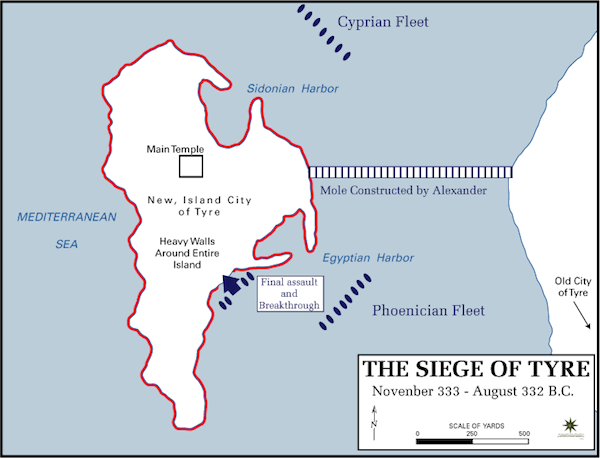In the first part of this series, we noted the siege equipment of the Assyrians consisted of complex battering rams, earthen ramps and a dedicated corps of engineers and sappers. Alexander the Great and the Greeks would take the next steps in the evolution of siege warfare. The Greeks had invented the catapult circa 399 B.C. Alexander innovated by fastening catapults and ballistas on the decks of ships to breach the walls of Tyre.
In January 332 B.C., Alexander began the Siege of Tyre. While the rest of the cities on the coast of modern Lebanon had surrendered to Alexander, he could not leave Tyre in the hands of the Persian fleet in his rear as he took his army to Egypt. Capturing Tyre was a strategic necessity for Alexander’s war plans.
Tyre, however, was seemingly impregnable. The massively fortified city was built on an island a half mile off the coast across from the old city on shore. The island had two natural harbors, one on each side. The landward walls towered 150 high. The Tryians knew Alexander was coming: they had evacuated the women and children and brought in food to sustain a siege. For the next seven months, a siege is what they got.
The Causeway
Alexander began the siege by directing his engineers to build a causeway (or mole) out to the fortified city. Rocks and stones taken from the old city, timbers, reeds and rubble provided the raw materials for the causeway. Water around the causeway was shallow until a certain point where it deepened to 18 feet. Meanwhile, the Tyrians were busy firing missiles at the workers, slowing the work.
Out towards the end of the causeway, which hadn’t yet reached the island, Alexander had two siege towers built. Each was 160 feet tall with catapults at the top to return fire at Tyre’s defenders and ballistas at the bottom to hurl rocks and pummel the walls. The catapult and ballistas could be covered with a metal plate to protect them. The engineers covered the wooden siege towers with animal hides to guard against fire.
The Tyrians found the causeway and artillery getting too close for comfort. In defence, the Tyrians took an old ship and filled it with combustible materials: pitch, chaff, torches and sulphur. They put cauldrons on the ship filled with inflammable oil. The defenders weighted the stern of the ship to tip the bow out of the water. Two galleys towed the fire ship, releasing it to drive it and themselves aground on the causeway. There, they fired the ship, which turned the end of the causeway into an inferno. Although besiegers frantically tried to put out the fire, the towers burned down.
Undaunted, Alexander ordered the causeway repaired and more siege towers constructed. These siege towers were mobile and were likely the tallest ever built. With catapults above and ballistas below, these artillery platforms could be moved right up to a city’s walls. At the same time, Alexander knew that only naval superiority would conquer the city. He then traveled to Sidon to fetch his fleet of 80 ships. The king of Cyprus, who wished to join Alexander’s conquests, sent another 120 galleys, while Ionia sent 23. Now Alexander’s fleet greatly outnumbered the Tyrian’s fleet.
On-Ship Battery Rams and Artillery Platforms
On his slower ships, Alexander mounted battery rams and modified siege towers with artillery. When he moved these ships close to the city walls, however, he discovered the defenders had thrown huge boulders into the sea, blocking close access to the walls. Alexander ordered those boulders chained and towed away and began circling the walls, searching for the weakest part of the walls.
The siege now entered its final, brutal stages. There were a number of attacks and counterattacks. Each side armored their leading ships. Tyre’s defenders continued to fire missiles at the besiegers, but now Alexander’s towers on the causeway and on the ships themselves were close enough to return death-dealing fire. Meanwhile, the besiegers discovered a small breach in the southern wall, facing the old city across the channel.
When Alexander could get his ships up to the walls, he set them to pounding the walls with battering rams and artillery from on-ship siege towers. While he sent some ships to create a diversion, Alexander took two ships with bridging equipment to the breached south wall. There the Macedonians swarmed over the bridge to the walls and forced a way into the city. Hundreds more soldiers followed and Tyre fell to Alexander in July 332 B.C.
While the massive siege towers on the causeway were only partially effective at Tyre, Alexander would use them again in the siege of Gaza, where they breached that city’s walls. In the case of Tyre, mounting battering rams and artillery siege towers on the decks of ships provided the means to breach the walls. This may be the first instance of on-ship artillery.
This article is part of our larger selection of posts about Ancient Greece. To learn more, click here for our comprehensive guide to Ancient Greece.
Cite This Article
"Engines of Destruction, The Evolution of Siege Warfare: Alexander the Great" History on the Net© 2000-2024, Salem Media.
April 17, 2024 <https://www.historyonthenet.com/engines-of-destruction-the-evolution-of-siege-warfare-alexander-the-great>
More Citation Information.
